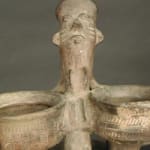Yoruba Terracotta Altar Vessel, 19th Century CE - 20th Century CE
Terracotta
9.5 x 14.5
PF.4799
Further images
Because the Yoruba believe the forces of the universe are in a constant state of flux and change, an artist is allowed a degree of freedom in the representation of...
Because the Yoruba believe the forces of the universe are in a constant state of flux and change, an artist is allowed a degree of freedom in the representation of these forces. To depict a deity requires faith and imagination; and both these crucial elements are apparent in this powerful vessel. The face on the handle is very human, and yet otherworldly at the same time. He is both independent of the vessel, and a fundamental part of it in his presenting of the two cups. The less abstract nature of the face suggests he may be the archetype human who is proudly making his offering of kola nuts placed in the cups and bowl. While images of the deities Ifa and Esu are frequently found on divination bowls and trays, their representation spans a fairly wide spectrum from the representational to the abstract. Whether man or god this figure towers above the 'earthly' world of the bowl, covered in striations like masses of jungle undergrowth. The region where he resides, with his head held high, is the land of the blessed, of ancestors and spirits who are humbly beseeched to intercede for the health and happiness of every man, woman and child.









